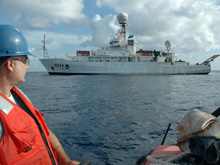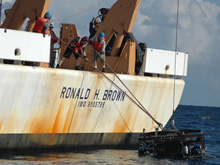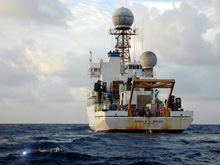Bosun Group Leader Dave Owen gazes back at the NOAA ship Ronald H. Brown, while piloting the ship's rigid-hull inflatable boat (RHIB). Click image for larger view and image credit.
During recovery, Dave LaPointe and Cody Harvey snag the Medea under the watchful eyes of Chief Bosun Bruce Cowden and Jason Expedition Leader Matt Heintz. Click image for larger view and image credit.
In a Class by Herself
July 2, 2007
LTJG James Brinkley
NOAA Ship Ronald H. Brown
26° 23.61 N
94° 30.91 W
![]() See just a few of the steps specifically associated with launching the Jason remotely operated vehicle (ROV). (Quicktime, 1.6 Mb.)
See just a few of the steps specifically associated with launching the Jason remotely operated vehicle (ROV). (Quicktime, 1.6 Mb.)
Since the research vessel (R/V) Ronald H. Brown is the only global class ship in the NOAA fleet, time onboard "the Brown" is a precious commodity among NOAA scientists. Every year there are many more ocean and atmospheric research projects proposed than there are available ship-days. During the year-and-a-half that I’ve sailed on her, the Brown has conducted numerous projects to further both NOAA climate and ecosystem research endeavors. This Expedition to the Deep Slope is one of just two ecosystem research projects planned during 2007 and 2008.
The story of the Brown started back in the early 1990s when NOAA recognized a need to upgrade its aging 1960s-era fleet. Designated as an auxiliary general ocean research (AGOR) vessel, the Brown was the last of 24 AGOR ships. In the winter of 1995, the keel was laid at Halter Marine Moss Point shipyard in Pascagoula, Mississippi, and within a short time construction was in full force. In following tradition, NOAA intended to name the ship Researcher, but during construction the U.S. secretary of commerce, the Honorable Ronald H. Brown tragically passed away in a plane crash while en route to the Balkans on April 3, 1996. As a fitting remembrance to the late government official, the ship was renamed and was launched on May 30, 1996, before a highly publicized audience.
Following the launch of the Brown, the ship departed Pascagoula began a two-month dry dock in New Orleans and the final installation phase at NOAA's Atlantic Marine Headquarters in Norfolk, Virginia. Following this outfitting period, the ship returned to its home port of Charleston, South Carolina, and on July 19, 1997, the ship sat smartly dressed, moored starboard side at pier Quebec. Before a large gathering, it was commissioned on that day as NOAA's first newly built oceanographic research vessel in 17 years.
Captain Gary Petrae keeps an eye on the Jason launch from the Brown’s flying bridge. Click image for larger view and image credit.
The teamwork and cooperation between the officers and crew of the R/V Ronald H. Brown and the Jason ROV group has resulted in more than 16 ROV lowerings — totaling more than 406 hours on the bottom. Click image for larger view and image credit.
Since its commissioning 10 years ago, the Brown has sailed around the world and transited the farthest reaches of its oceans. The ship has participated in scientific operations in three oceans and made port calls on six continents. With a vast array of oceanographic and atmospheric data logging equipment, the Brown is one of the world's foremost advanced research platforms. She has conducted air quality surveys, deployed tsunami and El Niño buoys, conducted conductivity-temperature-depth (CTD) testing in coastal and international waters, towed deep-water nets, and deployed ROVs to examine marine life on the ocean floor. Moreover, the Brown’s latest efforts have also involved working in a coordinated international project sampling Sahara dust, aerosols, and deploying ozonesondes (balloon-borne instruments) in attempt to improve knowledge and understanding of the West African Monsoon.
The Brown is equipped with a twin Z-drive propulsion system and variable azimuth bow thruster. Utilizing a sophisticated dynamic position system with integrated GPS inputs, combined with its advanced steering, the ship is able to participate and accomplish such projects with relative ease.
With a rigorous schedule, the Brown averages almost nine months of the year underway and logs over 30,000 nautical miles annually. She operates with a crew of 25 personnel.



































